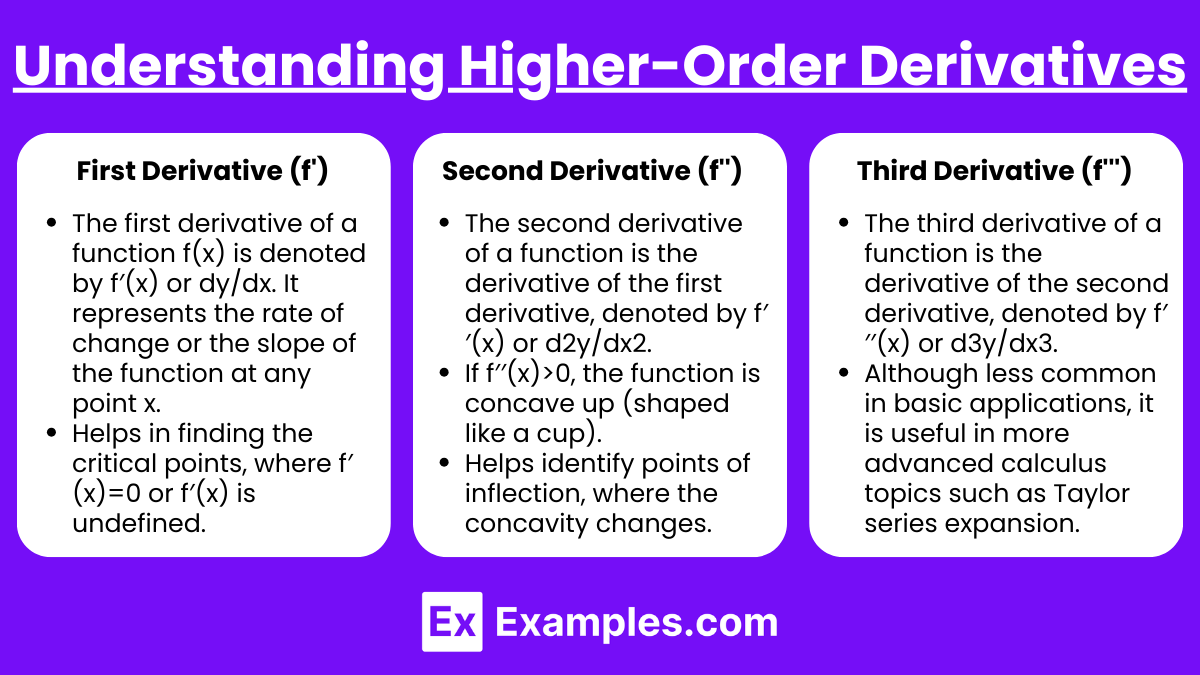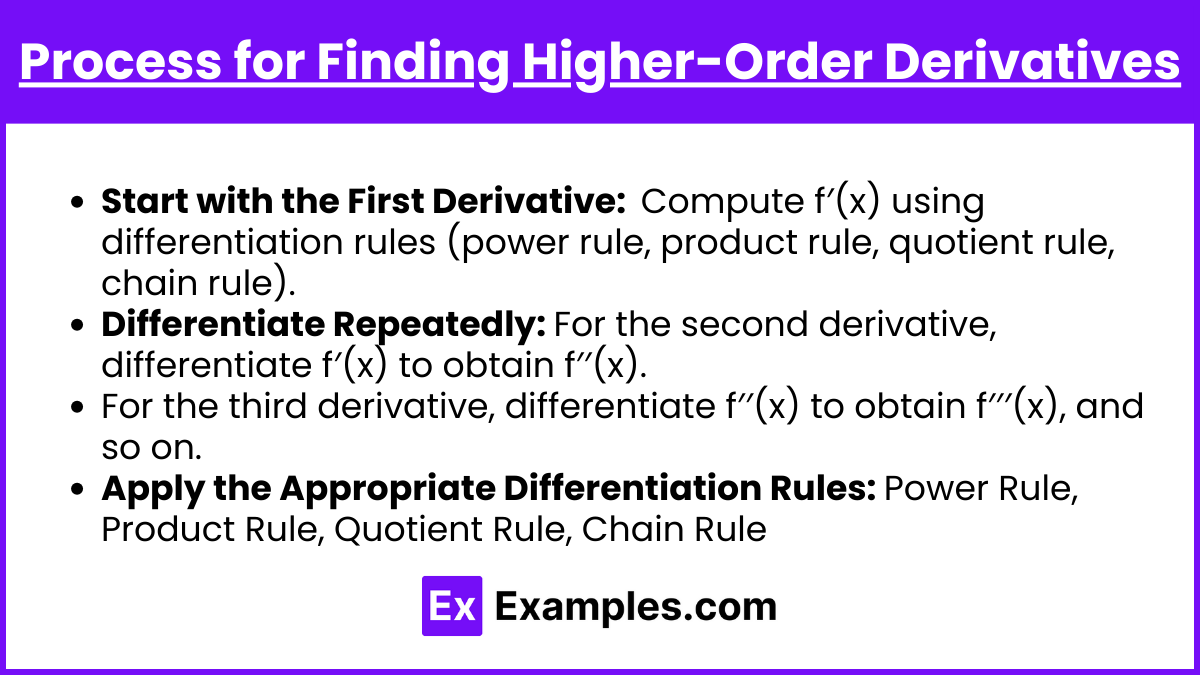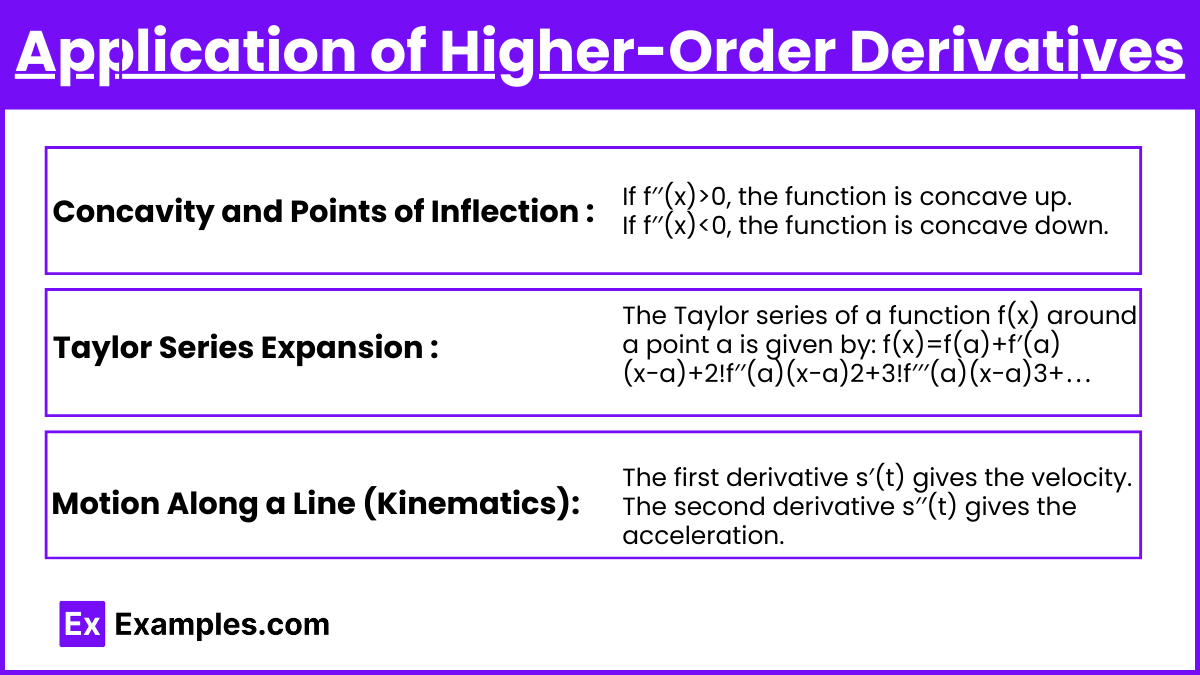Determining higher-order derivatives of functions is a fundamental concept in AP Calculus AB and BC. These derivatives, which involve taking the derivative of a function multiple times, are essential for analyzing the behavior of functions, including concavity, points of inflection, and more complex motion. In both AP Calculus AB and BC, understanding and applying higher-order derivatives is crucial for solving problems related to curve sketching, optimization, and Taylor series expansions, providing a deeper insight into the dynamics of functions.
Free AP Calculus AB Practice Test
Free AP Calculus BC Practice Test
Learning Objectives
By studying "Determining Higher-Order Derivatives of Functions" for the AP Calculus AB and BC exams, you should aim to understand how to calculate and interpret first, second, and higher-order derivatives of functions. This includes mastering differentiation techniques such as the power, product, quotient, and chain rules, and applying these to analyze the concavity, points of inflection, and behavior of functions. You should also learn to apply higher-order derivatives in contexts like Taylor series expansions and motion problems, essential for both AP Calculus AB and BC.
Understanding Higher-Order Derivatives

First Derivative (f')
The first derivative of a function f(x) is denoted by f′(x) or dy/dx. It represents the rate of change or the slope of the function at any point x.
Geometric Interpretation: The slope of the tangent line to the curve at a given point.
Application: Helps in finding the critical points, where f′(x)=0 or f′(x) is undefined.
Second Derivative (f'')
The second derivative of a function is the derivative of the first derivative, denoted by f′′(x) or d2y/dx2.
Geometric Interpretation: Indicates the concavity of the function.
If f′′(x)>0, the function is concave up (shaped like a cup).
If f′′(x)<0, the function is concave down (shaped like a cap).
Application: Helps identify points of inflection, where the concavity changes.
Third Derivative (f''')
The third derivative of a function is the derivative of the second derivative, denoted by f′′′(x) or d3y/dx3.
Geometric Interpretation: Provides information about the rate of change of the concavity.
Application: Although less common in basic applications, it is useful in more advanced calculus topics such as Taylor series expansion.
Higher-Order Derivatives
Higher-order derivatives beyond the third derivative (e.g., fourth, fifth, etc.) follow the same pattern. They are successively the derivatives of the previous derivative.
Notation:
Fourth derivative: f(4)(x) or
nth derivative: f(n)(x) or
Application: Higher-order derivatives are particularly important in topics like series expansions (e.g., Maclaurin and Taylor series).
Process for Finding Higher-Order Derivatives

Start with the First Derivative:
Compute f′(x) using differentiation rules (power rule, product rule, quotient rule, chain rule).
Differentiate Repeatedly:
For the second derivative, differentiate f′(x) to obtain f′′(x).
For the third derivative, differentiate f′′(x) to obtain f′′′(x), and so on.
Apply the Appropriate Differentiation Rules:
Power Rule:
Product Rule:
Quotient Rule:
Chain Rule:
Application of Higher-Order Derivatives

1. Concavity and Points of Inflection
Use the second derivative to determine concavity:
If f′′(x)>0, the function is concave up.
If f′′(x)<0, the function is concave down.
A point of inflection occurs where f′′(x)=0 and the concavity changes.
2. Taylor Series Expansion
The Taylor series of a function f(x) around a point a is given by: f(x)=f(a)+f′(a)(x−a)+2!f′′(a)(x−a)2+3!f′′′(a)(x−a)3+⋯
Higher-order derivatives are used to find the coefficients of the series.
3. Motion Along a Line (Kinematics)
In physics, if s(t) represents the position of a particle at time t:
The first derivative s′(t) gives the velocity.
The second derivative s′′(t) gives the acceleration.
The third derivative s′′′(t) gives the jerk (rate of change of acceleration).
Examples
Example 1: Higher-Order Derivatives of a Constant Function
Let f(x)=7.
The first derivative is f′(x)=0.
The second derivative is f′′(x)=0.
The third derivative is f′′′(x)=0.
The fourth derivative is f(4)(x)=0.
Since the function is a constant, all derivatives are zero.
Example 2: Higher-Order Derivatives of a Linear Function
Consider f(x)=3x.
The first derivative is f′(x)=3.
The second derivative is f′′(x)=0.
The third derivative is f′′′(x)=0.
The fourth derivative is f(4)(x)=0.
After the first derivative, all higher derivatives are zero.
Example 3: Higher-Order Derivatives of a Quadratic Function
Let f(x)=x2.
The first derivative is f′(x)=2x.
The second derivative is f′′(x)=2.
The third derivative is f′′′(x)=0.
The fourth derivative is f(4)(x)=0.
After the second derivative, all higher derivatives are zero.
Example 4: Higher-Order Derivatives of a Cubic Function
Consider f(x)=x3.
The first derivative is f′(x)=3x2.
The second derivative is f′′(x)=6x.
The third derivative is f′′′(x)=6.
The fourth derivative is f(4)(x)=0.
The third derivative is constant, and all higher derivatives are zero.
Example 5: Higher-Order Derivatives of a Sine Function
Let f(x)=sin(x).
The first derivative is f′(x)=cos(x).
The second derivative is f′′(x)=−sin(x).
The third derivative is f′′′(x)=−cos(x).
The fourth derivative is f(4)(x)=sin(x).
The derivatives cycle every four steps, repeating the original function.
Multiple Choice Questions
Question 1
What is the second derivative f′′(x) of the function f(x)=4x3?
A) 24x2
B) 12x2
C) 24x
D) 12x
Correct Answer: C) 24x
Explanation: First, find the first derivative of f(x) = 4x3:
f′(x) = 12x2
Next, differentiate f′(x) to find the second derivative:f′′(x) = 24x
Thus, the correct answer is C.
Question 2:
If g(x)=x4−2x2+3, what is the third derivative g′′′(x)?
A) 24x
B) 12x2
C) 48x
D) 0
Correct Answer: A) 24x
Explanation:
First, find the first derivative: g′(x) = 4x3−4x
Next, find the second derivative: g′′(x) = 12x2−4
Finally, differentiate g′′(x) to find the third derivative: g′′′(x) = 24x
Thus, the correct answer is A.
Question 3
For the function h(x) = cos(x), what is the fourth derivative h(4)(x)?
A) cos(x)
B) −cos(x)
C) sin(x)
D) −sin(x)
Correct Answer: A) cos(x)
Explanation:
First, find the first derivative: h′(x) = −sin(x)
Next, find the second derivative: h′′(x) = −cos(x)
Then, find the third derivative: h′′′(x) = sin(x)
Finally, find the fourth derivative: h(4)(x) = cos(x)
Since the derivatives of trigonometric functions cycle every four steps, the fourth derivative returns to the original function cos(x). Thus, the correct answer is A.


